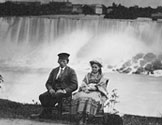

|
||||||||||||||||||||||||||||||||||||||
|
|
||||||||||||||||||||||||||||||||||||||
 |
 |
 |
 |
 Niagara Falls Reservation State Park Niagara Falls, the “honeymoon capital” of the world, has been delighting tourists for hundreds of year. By the beginning of the 19th century, the natural beauty of Niagara Falls began to suffer as over-zealous industrialists built mills and factories along the Niagara River to harness its power. To make matters worse, the lands around the Falls had grown to include a pretty unsightly group of vendors and shanties housing amusements of every conceivable description. In the midst of these structures, numerous “hackmen” (carriage drivers for hire) plied their trade. The situation had become so severe that critics of the condition said that tourists to Niagara Falls were being “hacked to death.”
Olmstead’s vision became fiat in 1865 when the state created the Niagara Reservation, the oldest state park in the United States. Today, the Niagara Reservation State Park is responsible for the care and preservation of all the land that surrounds Niagara Falls, including numerous islands, as well as the famous Prospect Point area.
Douglas Farley, Director |
|